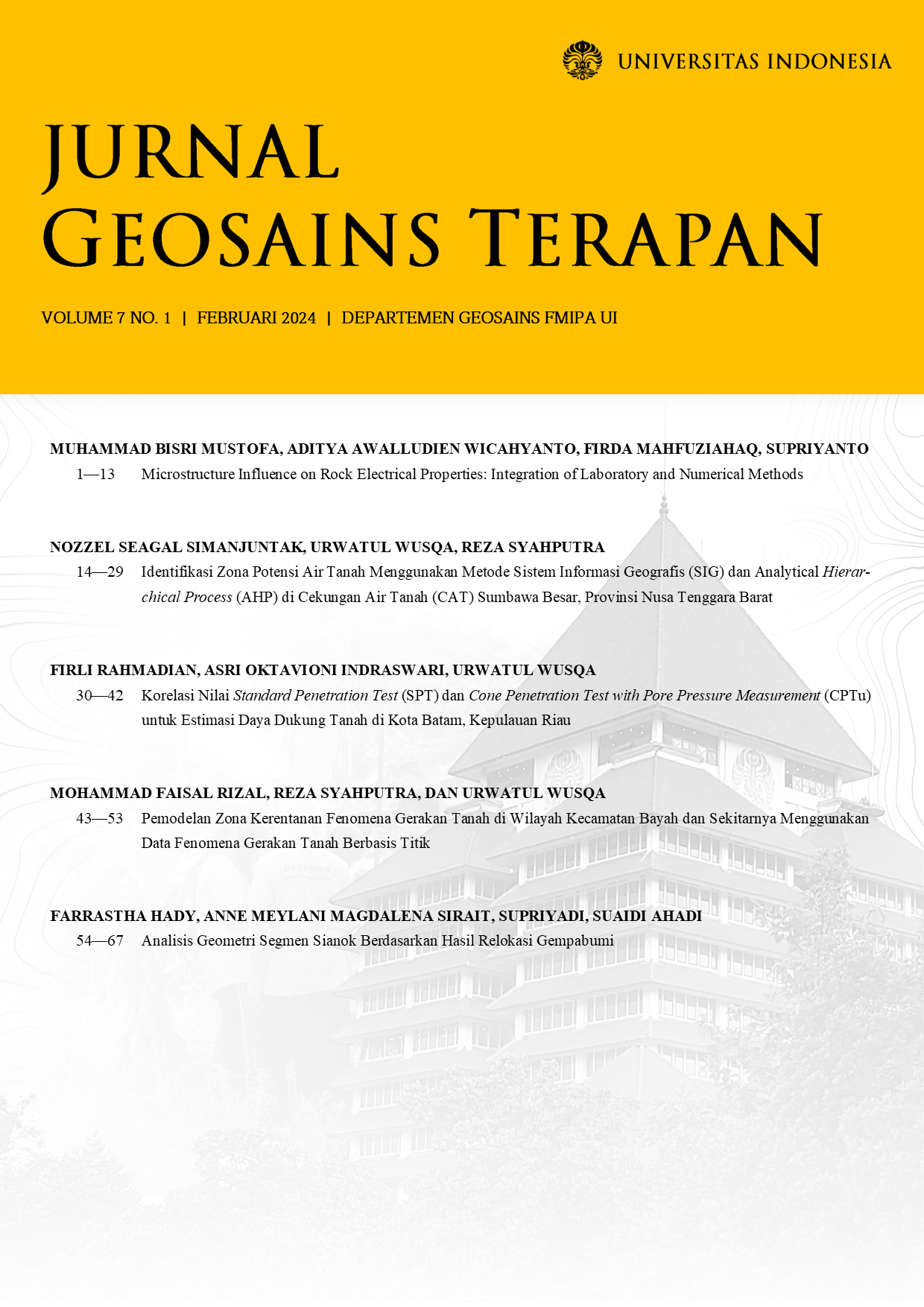Analisis Geometri Segmen Sianok Berdasarkan Hasil Relokasi Gempabumi
DOI:
https://doi.org/10.64986/jgt.v7i1.125Kata Kunci:
sesar Sianok, geometri sesar, hypoDD, segmentasi sesarAbstrak
Penelitian ini bertujuan untuk menganalisis geometri segmen Sianok berdasarkan hasil relokasi gempabumi, dengan fokus pada parameter arah strike, kemiringan (dip), panjang, dan kedalaman segmen. Wilayah penelitian terletak di sekitar segmen Sianok, dengan batas koordinat 100 BT–101° BT dan 0,8° LS–0,2° LU. Data yang digunakan berupa waktu tiba gelombang gempa (arrival time) dari BMKG dengan rentang waktu Oktober 2021 hingga April 2025. Relokasi dilakukan menggunakan metode double-difference (HypoDD) untuk memperoleh lokasi hiposenter yang lebih presisi.Hasil relokasi menunjukkan peningkatan akurasi posisi gempa, yang divalidasi menggunakan kurva residual, metode jackknife, uji robustness, serta analisis arah perpindahan melalui diagram rose dan diagram kompas. Berdasarkan hasil analisis, jalur sesar terbagi menjadi lima segmen dengan arah strike dominan barat laut–tenggara (NW–SE). Panjang segmen bervariasi antara 4,44 km hingga 13,32 km. Sebagian besar segmen memiliki kemiringan curam (dip > 65°), mencerminkan dominasi mekanisme sesar geser. Kedalaman hiposenter berada di kisaran 0–30 km, dengan konsentrasi pada kedalaman 5–15 km.Segmentasi sesar ini bersifat tidak kontinyu, ditunjukkan oleh pemisahan kluster gempa yang membentuk segmen-segmen terpisah, masing-masing dengan potensi kegempaan tersendiri. Temuan ini penting untuk pemodelan potensi bahaya gempa bumi di wilayah sekitar jalur sesar Sianok.
Referensi
Andrews, V., Joann, S., Vazquez, C. A., & Davila, G. R. (2011). Double-difference Relocation of the Aftershocks of the Tecoma´n, Colima, Mexico Earthquake. Pure and Applied Geophysics. https://doi.org/10.1007/s00024-010-0203-0
Asy'tama, H. S. (2022). Identifikasi Sesar Sumatera Segmen Sianok Menggunakan Metode MS-SVD (Multi Scale - Second Vertical Derivative) Data Gravitasi Untuk Mitigasi Kebencanaan Seismik. Universitas Indonesia.
Badan Nasional Penanggulangan Bencana (BNPB). (2023, April 8). Gempa Padang Panjang 28 Juni 1926 dalam Surat Kabar Kolonial. Retrieved from Portal Literasi Sejarah Bencana: https://sejarah.dibi.bnpb.go.id/artikel/gempa-padang-panjang-28-juni-1926-dalam-surat-kabar-kolonial/65
D'Alessandro, A., Luzio, D., D'Anna, G., & Mangano, G. (2011). Seismic Network Evaluation through Simulation: An Application to the Italian National Seismic Network. Bulletin of the Seismological Society of America. https://doi.org/10.1785/0120100066
Efron, B. (1982). The jacknife, the bootstrap, and other resampling plans. Philadelphia: SIAM.
Kementrian Energi dan Sumber Daya Mineral. (n.d.). Peta Geologi Sumatera Barat. Retrieved from Geomap: https://geologi.esdm.go.id/geomap/pages/province/13
Kennett, B. L. (1995). Constraints on seismic velocities in the Earth from traveltimes. Geophysical Journal International.
Lay, T., & Wallace, T. C. (1995). Modren Global Seismology. Academic Press.
Natawidjaja, D. H. (2007). The Sumatran Fault Zone - From Source to Hazard. Journal of Earthquake and Tsunami, 21-47.
Pusat Studi Gempa Nasional (PUSGEN). (2017). Peta Sumber dan Bahaya Gempa Indonesia Tahun 2017. Kabupaten Bandung: Kementerian Pekerjaan Umum dan Perumahan Rakyat Republik Indonesia.
Salman, R., Lindsey, E. O., Feng, L., Bradley, K., & al, e. (2020). Structural Controls on Rupture Extent of Recent Sumatran Fault Zone Earthquakes, Indonesia. Journal of Geophysical Research: Solid Earth. https://doi.org/10.1029/2019JB018101
Sieh, K., & Natawidjaja, D. (2000). Neotectonics of the Sumatran fault, Indonesia. Journal of Geophysical Research. https://doi.org/10.1029/2000JB900120
Sihotang, B. (2024). An updated 1-dimensional seismic velocity model has been developed for the Mw 6.1 Pasaman earthquake that occurred on February 25, 2022. Journal of Applied Geospatial Information. https://doi.org/10.30871/jagi.v8i1.7593
Stein, S., & Wysession, M. (2003). An Introduction to Seismology, Earthquakes, and Earth Structure. Blackwell Publishing.
Supendi, P., Nugraha, A. D., Puspito, N. T., Widiyantoro, S., & Daryono, D. (2018). Identification of active faults in West Java, Indonesia, based on earthquake hypocenter determination, relocation, and focal mechanism analysis. Geosience Letters. https://doi.org/10.1186/s40562-018-0130-y
Syafriani. (2023). Study of Seismicity Based on the Results of Hypocenter Relocation Using Double Difference (HypoDD) Method in West Sumatera and Its Surrounding. Journal of Research in Science Education. https://doi.org/10.29303/jppipa.v9i7.3792
USGS. (2020). ANSS Comprehensive Earthquake Catalog (ComCat) Documentation. Retrieved from Earthquake Hazard Program: https://earthquake.usgs.gov/data/comcat/
Waldhauser , F., & Schaff, D. P. (2008). Large-scale relocation of two decades of Northern California seismicity using cross-correlation and double-difference methods. JOURNAL OF GEOPHYSICAL RESEARCH. https://doi.org/10.1029/2007JB005479
Waldhauser, F., & Ellsworth, W. L. (2000). A Double-Difference Earthquake Location Algorithm: Method and Application on the Northen Hayward Fault, California. Bulletin of the Seismological Society of America. https://doi.org/10.1785/0120000006
Wells, D. L., & Coppersmith, K. J. (1994). New Empirical Relationships among Magnitude, Rupture Lenght, Rupture Width, Rupture Area, and Surface Displacement. Bulletin of the Seismological Society of America. https://doi.org/10.1785/BSSA0840040974
Zhang , H., & Thurber, C. H. (2003). Double-Difference Tomography: The Method and Its Application to the Hayward Fault, California. Bulletin of the Seismological Society of Americ. https://doi.org/10.1785/0120020190
Unduhan
Diterbitkan
Cara Mengutip
Lisensi
Hak Cipta (c) 2025 Jurnal Geosains Terapan

Artikel ini berlisensi Creative Commons Attribution-NonCommercial-NoDerivatives 4.0 International License.


